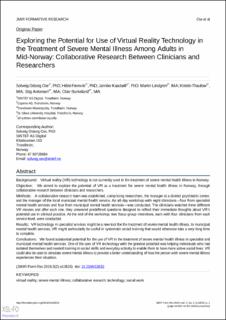| dc.contributor.author | Ose, Solveig Osborg | |
| dc.contributor.author | Færevik, Hilde | |
| dc.contributor.author | Kaasbøll, Jannike | |
| dc.contributor.author | Lindgren, Martin | |
| dc.contributor.author | Thaulow, Kristin | |
| dc.contributor.author | Antonsen, Stig | |
| dc.contributor.author | Burkeland, Olav | |
| dc.date.accessioned | 2021-02-11T12:59:36Z | |
| dc.date.available | 2021-02-11T12:59:36Z | |
| dc.date.created | 2019-08-12T14:49:38Z | |
| dc.date.issued | 2019 | |
| dc.identifier.citation | JMIR Formative Research. 2019, 3 (2), e13633-e13633. | en_US |
| dc.identifier.issn | 2561-326X | |
| dc.identifier.uri | https://hdl.handle.net/11250/2727450 | |
| dc.description.abstract | Background: Virtual reality (VR) technology is not currently used in the treatment of severe mental health illness in Norway.
Objective: We aimed to explore the potential of VR as a treatment for severe mental health illness in Norway, through
collaborative research between clinicians and researchers.
Methods: A collaborative research team was established, comprising researchers, the manager at a district psychiatric center,
and the manager of the local municipal mental health service. An all-day workshop with eight clinicians—four from specialist
mental health services and four from municipal mental health services—was conducted. The clinicians watched three different
VR movies and after each one, they answered predefined questions designed to reflect their immediate thoughts about VR’s
potential use in clinical practice. At the end of the workshop, two focus group interviews, each with four clinicians from each
service level, were conducted.
Results: VR technology in specialist services might be a new tool for the treatment of severe mental health illness. In municipal
mental health services, VR might particularly be useful in systematic social training that would otherwise take a very long time
to complete.
Conclusions: We found substantial potential for the use of VR in the treatment of severe mental health illness in specialist and
municipal mental health services. One of the uses of VR technology with the greatest potential was helping individuals who had
isolated themselves and needed training in social skills and everyday activity to enable them to have more active social lives. VR
could also be used to simulate severe mental illness to provide a better understanding of how the person with severe mental illness
experiences their situation. | en_US |
| dc.language.iso | eng | en_US |
| dc.publisher | JMIR Publications | en_US |
| dc.relation.uri | https://formative.jmir.org/2019/2/e13633/citations | |
| dc.rights | Navngivelse 4.0 Internasjonal | * |
| dc.rights.uri | http://creativecommons.org/licenses/by/4.0/deed.no | * |
| dc.subject | virtual reality | en_US |
| dc.subject | severe mental illness | en_US |
| dc.subject | collaborative research | en_US |
| dc.subject | technology | en_US |
| dc.subject | social work | en_US |
| dc.title | Exploring the Potential for Use of Virtual Reality Technology in the Treatment of Severe Mental Illness Among Adults in Mid-Norway: Collaborative Research Between Clinicians and Researchers | en_US |
| dc.type | Peer reviewed | en_US |
| dc.type | Journal article | en_US |
| dc.description.version | publishedVersion | en_US |
| dc.rights.holder | ©Solveig Osborg Ose, Hilde Færevik, Jannike Kaasbøll, Martin Lindgren, Kristin Thaulow, Stig Antonsen, Olav Burkeland.
Originally published in JMIR Formative Research (http://formative.jmir.org), 10.06.2019. This is an open-access article distributed
under the terms of the Creative Commons Attribution License (https://creativecommons.org/licenses/by/4.0/), which permits
unrestricted use, distribution, and reproduction in any medium, provided the original work, first published in JMIR Formative
Research, is properly cited. The complete bibliographic information, a link to the original publication on http://formative.jmir.org,
as well as this copyright and license information must be included. | en_US |
| dc.source.pagenumber | e13633-e13633 | en_US |
| dc.source.volume | 3 | en_US |
| dc.source.journal | JMIR Formative Research | en_US |
| dc.source.issue | 2 | en_US |
| dc.identifier.doi | 10.2196/13633 | |
| dc.identifier.cristin | 1715341 | |
| dc.relation.project | Regionale forskningsfond Midt-Norge: 284892 | en_US |
| cristin.unitcode | 7401,90,25,0 | |
| cristin.unitcode | 7401,90,0,0 | |
| cristin.unitname | Helse | |
| cristin.unitname | SINTEF Digital | |
| cristin.ispublished | true | |
| cristin.fulltext | original | |
| cristin.qualitycode | 1 | |

